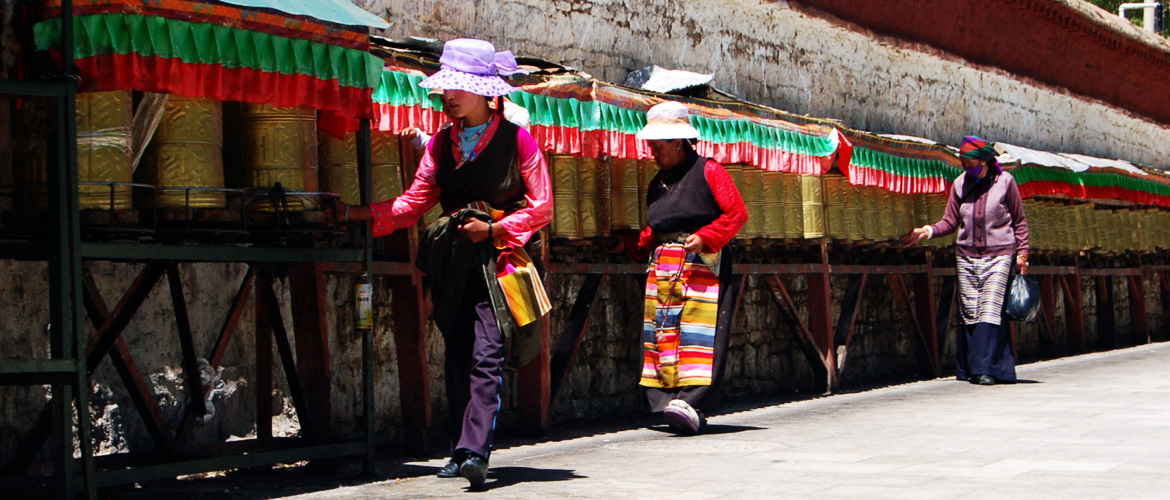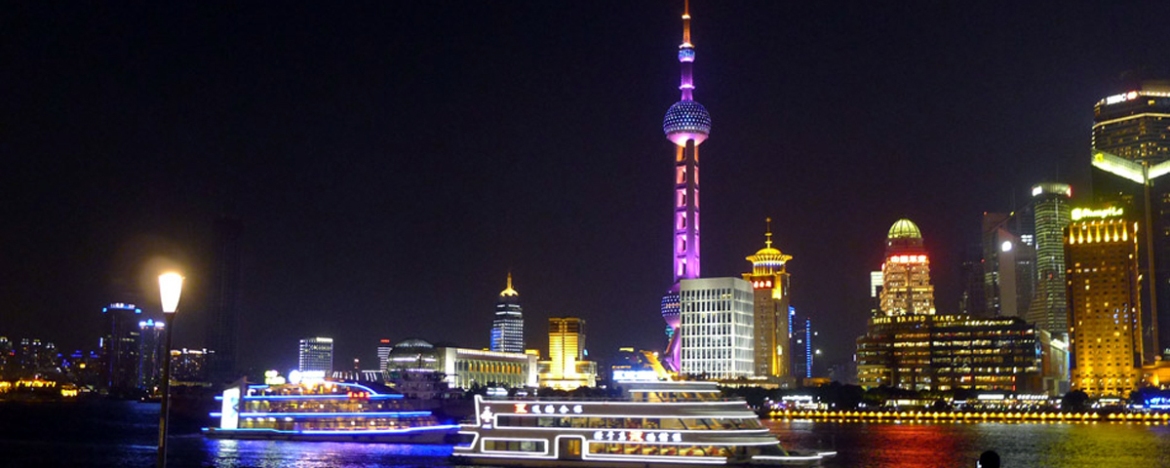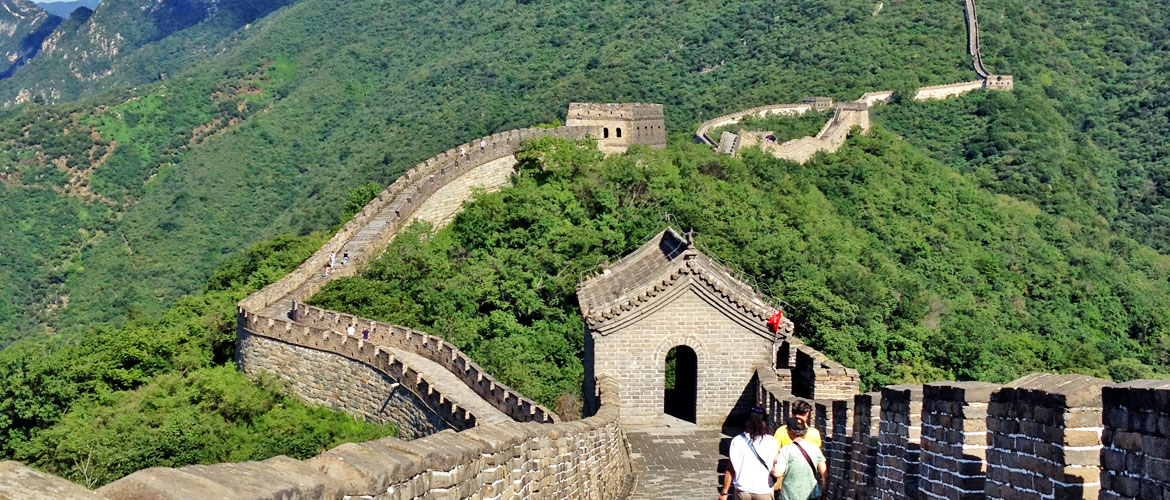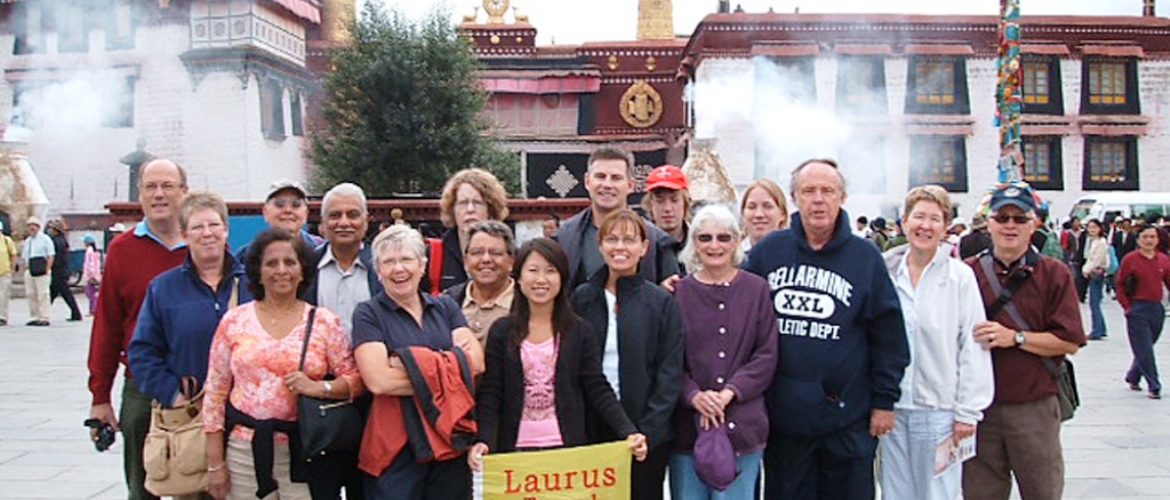
Beijing – Xi’an – Chengdu – Lhasa – Gyantse – Shigatse – Lhasa – Chongqing – Shanghai
Join us on this exciting journey to Tibet – the Roof of the World! Expert guides, small group size, no forced shopping, gourmet food, and loads of fun – those are the important features of this luxury China tour with Tibet. Trip highlights include Potala Palace, Yamdrok Yumtso (lake), Gyantse Fortress, Tibetan family visit, the Great Wall, and Chengdu Giant Panda Research Center.
High above the clouds, where the land touches the sky, Tibet stands as a mystical realm of breathtaking landscapes, profound spirituality, and ancient traditions. Known as the “Roof of the World,” this remote plateau is not just a destination—it’s an awakening. Every traveler who sets foot on this sacred land leaves transformed, carrying with them the spirit of Tibet forever.
Please note that the tour reaches points as high as 5,020 metres above sea level. Participants prone to altitude sickness must take precaution.
Important Features
- Small group size – average 15, maximum 20.
- Expert local guides hand-picked by company owners.
- No shopping stops.
- Quality meals at non-tourist restaurants.
- Unlimited supply of bottled water during group activities.
- Great Wall visit at Mutianyu with cable car.
Options Available
- Peking opera show in Beijing.
- Princess Wencheng stage performance in Lhasa.
- Face Mask Changing performance in Chengdu.
Meal Code: B = breakfast / L = lunch / D = dinner
Day 1/Thu: Departing for Beijing
The trip starts with your transpacific flight departing from a city of your choice. You’ll lose a day upon crossing the International Date Line.
Day 2/Fri: Arrival in Beijing
Meet the driver on arrival for transfer to the hotel. You’ll have the remainder of the day at leisure. The guide will get in touch with you tonight.
Day 3/Sat: Beijing (B/L/D)
The capital of China, Beijing is a world-class cultural and educational centre with a population of 21.9 million (2020), ranking it China’s second largest city behind Shanghai. Beijing is renowned for its opulent palaces, temples, and huge stone walls and gates – treasures that make it the most popular tourist city in China by the number of visitors it receives every year.
We begin our sightseeing today at the Forbidden City. Officially known as the Palace Museum, the Forbidden City was the place where the emperors of the Ming (1368-1644) and Qing (1644-1912) dynasties lived and carried out their administration. Construction of the Forbidden City took 14 years (1406-1420) to complete. The complex consists of 980 buildings and covers 72 hectares or 180 acres. It exemplifies traditional Chinese palatial architecture and has influenced cultural and architectural developments in East Asia and elsewhere.
Tian’anmen Square comes next. Located in the heart of Beijing, the square measures 880 metres from north to south and 500 meters from east to west. Said to be the largest public plaza in the world, Tian’anmen Square has the capacity to hold one million people. The imposing Tian’anmen Tower sits at the north end of the square while the Monument to the People’s Heroes dominates the centre. The square is flanked by The Great Hall of the People (west) and the National Museum (east). Chairman Mao’s Mausoleum and Qianmen (Front Gate) are located in the south of the square.
Afternoon sightseeing takes place at the Temple of Heaven. Situated in southeastern Beijing, the Temple of Heaven is China’s largest extant sacrificial temple where, during the Ming and Qing Dynasties, the emperors conducted the elaborate and most exalted sacrifices addressed to “the Supreme Ruler of the Universe”. Construction of the temple started in 1406, during the reign of the Ming Emperor Yongle, and took 14 years to complete. The temple was expanded under the Qing emperors Qianlong (1736-1796) and Jiaqing (1796-1820). Occupying 2.73 square kilometres (roughly 1,700 by 1,600 metres), the area of the Temple of Heaven is more than twice that of the Forbidden City.
The famous Hongqiao Pearl Market, the largest pearl market in the world, is right across the street from the Temple of Heaven. Recommended by numerous guidebooks for freshwater pearls, Hongqiao teems with domestic and international shoppers. If you are interested, please ask the guide to drop you off there. However, you’ll need to get back to the hotel by taxi, which costs about 8 US dollars.
Today we enjoy a delicious dinner at a popular Peking Roast Duck restaurant. Peking Roast Duck is a famous Beijing dish prized for the thin and crispy skin with authentic versions serving mostly the skin and little meat, sliced in front of the diners. The meat is wrapped in a thin layer of pancake (Chinese tortilla) together with shredded scallion, cucumber, and a sweet and salty sauce made of wheat flour. Condiments may also include pickled garlic and white sugar.
Day 4/Sun: Beijing (B/L)
After an early breakfast we embark on a full-day excursion to the legendary Great Wall at Mutianyu, 75 km northeast of the city.
Zigzagging over 6,000 kilometres from east to west along the undulating mountains, the Great Wall was built to hold off tribal invaders from the north. As history shows, the Wall failed the Chinese rulers miserably, especially in the case of Kublai Khan whose men swept across China from the Mongolian steppe, thus marking the beginning of the Yuan Dynasty (1279-1368).
Construction of the earliest sections of the Wall started in the 7th century BCE. A major renovation started with the founding of the Ming Dynasty in 1368 and took 200 years to complete. The wall we see today in Beijing is almost exactly the result of this effort.
Day 5/Mon: Beijing – Xi’an (B/L/D)
We begin our sightseeing today with a visit to a traditional hutong neighbourhood. Hutong refers to an ancient alleyway with siheyuan or ”4-sided courtyard house” on both sides. The name hutong dates back to the Yuan Dynasty (1279 – 1368 CE). According to some experts, the word originated from the Mongolian language, in which it is pronounced as “hottog” and means “well.” In ancient times, people tended to gather and live around wells. Therefore, the original meaning of hutong should be “a place where people live around”.
Next on our schedule is the Summer Palace, a well preserved UNESCO World Cultural Heritage Site. The imperial resort was first named Garden of Clear Ripples, which was burnt down by the allied forces of Great Britain and France in 1860 at the end of the Second Opium War (referred to as Arrow War by the British). Reconstruction started 25 years later and was completed in 1895 when the name was changed to Yi He Yuan (Garden of Good Health and Harmony). The design gives prominence to Longevity Hill, as well as Kunming Lake south of the hill. The sprawling complex covers an area of 290 hectares and the buildings inside consist of over 3,000 bays.
We travel to Xi’an by high-speed train (#G87, 14:00/18:23). The 4-hour-23-minute rail journey through fertile farmland dotted with villages provides the visitor with an excellent way to enjoy the beautiful countryside. The track we travel on between Beijing and Zhengzhou is part of the new 2,298 km high-speed railway linking Beijing and subtropical Guangzhou and is also the longest high-speed rail line in the world. In the past 20 years China has been on a building spree expanding the country’s rail network and upgrading existing railways. Its new high-speed rail service rivals France’s TGV and Japan’s “shinkansen” in terms of safety, speed, comfort and punctuality.
Day 6/Tue: Xi’an (B/L)
With a history going back over 3,000 years, Xi’an served as China’s capital of several ruling dynasties including the Han (206 BCE – 220 CE) and the Tang (618 – 907). It is home to the famous Terracotta Army and the eastern terminus of the ancient Silk Road – a network of trade routes connecting China proper with regions as far as the Mediterranean beginning in the Second Century BCE.
We spend the morning visiting the Terracotta Army. Built on the excavation site, the museum is located 30 km east of the city. Designed to follow the first emperor of the Qin Dynasty (221-206 BCE) into eternity, the Terracotta Army represents one of the greatest archeological discoveries of the 20th century.
After lunch we return to the city for a stroll on the ancient city wall. Declared a national treasure by the State Council in 1961, the wall (first built in 1370) encircles an area of 14 square kilometres. It runs 13.7 kilometres long and measures 12 metres in height with a thickness at the base between 15 to 18 metres.
Day 7/Wed: Xi’an – Chengdu (B/L/D)
Morning sightseeing begins at Shaanxi Provincial Museum. The modern, well-organized museum was completed in 1992 and traces the history of Xi’an from prehistory to the Qing dynasty (1644-1912). The extensive galleries and exhibitions offer the visitor an excellent introduction to the area that greatly improves understanding of the numerous historical sites in and around the city.
We then visit the grand mosque in the old town centre and the adjacent Muslim bazaar. The mosque was established in the 8th century but the majority of the complex was constructed in the Ming Dynasty (1368-1644). It was further expanded in the Qing Dynasty. Unlike most mosques in Middle Eastern or Arab countries, this mosque is completely Chinese in architectural style. It has neither domes nor traditional minarets.
This afternoon we ride the bullet train (G1975, 14:34/18:25) to Chengdu, the capital of populous Sichuan Province. The ancient city has a population of 14 million with half of that within the urban centre and the remainder in the surrounding districts. The fertile Chengdu Plain, on which Chengdu is located, is also known as “Country of Heaven”, a phrase also often translated as “The Land of Abundance”. The discovery of the Jinsha site suggests the area of Chengdu had become the centre of the Bronze Age Sanxingdui culture around the time of the establishment of the state of Shu, prior to its annexation by Qin in 316 BCE.
Day 8/Thu: Chengdu (B/L)
Morning sightseeing takes place at Chengdu Research Base of Giant Panda Breeding. The giant panda, unrelated to the red or lesser panda, is a bear native to south central China, living in mountainous regions. It is easily recognized by the large, distinctive black patches around its eyes, over the ears, and across its round body. Though it belongs to the order Carnivora, the panda’s diet is over 99% bamboo. The giant panda has an insatiable appetite for bamboo. A typical animal eats half the day – a full 12 out of every 24 hours – and relieves itself dozens of times a day. Giant pandas are solitary creatures. They have a highly developed sense of smell that males use to avoid each other and to find females for mating in the spring. After a five-month pregnancy, females give birth to a cub or two, though they cannot care for both twins. The blind infants, born fully white, weigh only 5 ounces (142 grams) at birth and cannot crawl until they reach three months of age.
The panda is a conservation reliant species. Recent statistics show 637 pandas living in captivity with most of them inside China. The most authoritative estimate as of late 2022 puts the number of giant pandas living in the wilderness at 1864.
We spend most of the afternoon at Jinsha Museum. In February 2001, construction workers chanced upon a significant archaeological discovery in modern China. The discovery led to the naming of Jinsha culture (1200 – 650 BCE) and a museum was erected at the excavation site. Jinsha culture flourished around 1000 BCE and shares similarities in burial objects with the Sanxingdui site located 50 km from Chengdu. Objects made of ivory, jade, bronze, gold and stone were unearthed at the site. Unlike the site at Sanxingdui, Jinsha did not have a city wall. Jinsha culture is believed to be a final phase of Sanxingdui civilization and represents a relocation of the political center in the ancient Shu Kingdom.
Day 9/Fri: Chengdu – Lhasa (B/L/D)
We board an early morning flight (2 hours 30 minutes) for Lhasa and spend the remainder of the day relaxing to get acclimated to the high altitudes.
Situated in a wide, mountain-fringed valley on the north bank of the Kyichu River, Lhasa (elevation 3,650m) is a rapidly expanding city with a population around 870,000 as of late 2022. An important settlement for well over a thousand years, Lhasa was originally called Rasa, but was renamed by King Songtsen Gampo in the 7th century when he moved his capital here from the Yarlung Valley. Following the collapse of the Yarlung dynasty two centuries later, power dispersed among local chieftains and the city lost its pre-eminence. It was not until the 17th century, with the installation of the Fifth Dalai Lama as ruler by Gushri Khan, a Mongolian prince and later leader of the Khoshut Khanate, that Lhasa once again became the seat of government.
Day 10/Sat: Lhasa (B/L)
Morning visit to Norbulinka, literally meaning jeweled park. First built in 1755, Norbulingka covers an area of 89 acres and served as the traditional summer residence of the successive Dalai Lamas. A short distance to the southwest of the Potala Palace, Norbulingka forms part of a UNESCO World Heritage Site collectively known as the Historic Ensemble of the Potala Palace.
This afternoon we tour the grand Sera Monastery, where lively debates held every day except Sunday between resident monks often draw a large audience. Sera Monastery is recognized as one of the “great three” Gelug university monasteries of Tibet together with Ganden Monastery and Drepung Monastery.
Day 11/Sun: Lhasa (B/L)
This morning we visit the Potala Palace. This was the chief residence of the Dalai Lama until the 14th Dalai Lama fled to India during the 1959 Tibetan uprising. Now a museum, the palace is named after Mount Potalaka, the mythical abode of the bodhisattva Avalokitesvara. The 5th Dalai Lama started its construction in 1645 after one of his spiritual advisers pointed out that the site was ideal as a seat of government, situated as it is between Drepung and Sera monasteries and the old city of Lhasa. The palace sits on the site of an earlier fortress built by King Songtsen Gampo. The main building measures 360 metres east-west and 140 metres north-south. Thickness of the exterior granite walls varies between 2 and 5 metres.
Afternoon sightseeing at Jokhang Temple, one of the oldest Buddhist buildings in Tibet and a remarkable combination of Tibetan, Indian, Nepalese and Han Chinese architectural styles. No visit to Jokhang Temple is complete without checking out the Barkor Street bazaar outside the temple.
Day 12/Mon: Lhasa – Gyantse – Shigatse (B/L/D)
Following breakfast, we drive along the Southern Route to Gyantse (265 km).
Highlights of the scenic drive include Kambaba Pass (4700 metres/15416 feet above sea level) and the sacred Yamdrok Lake. Every summer throngs of Tibetan pilgrims come to the lake to pray for blessings by the lake goddess.
Afternoon sightseeing in Gyantse takes in the Fortress of Gyantse Dzong and Pelkhor Choede. We then continue on to Shigatse (90 km) in late afternoon arriving at the second largest city in Tibet around dinnertime.
Day 13/Tue: Shigatse – Lhasa (B/L)
This morning we tour Tashilunpo Monastery, the religious and administrative headquarters of the Panchen Lama – paramount leader of the Yellow Sect of Tibetan Buddhism. Visit to a local Tibetan family is also on the itinerary.
After lunch we drive back to Lhasa via a different route – better paved Northern Route (295 km). Vast pastureland, barren mountain slopes, snow-capped peaks, blue skies, white clouds, scanty population, and ubiquitous prayer flags – these images combine to conjure a sense of solitude and mystery.
Day 14/Wed: Lhasa (B)
Free day to explore on your own. For a small fee, we can organize a visit to a local elementary school or a hospital practicing traditional Tibetan medicine.
Day 15/Thu: Lhasa – Chongqing (B/L/D)
We travel to Chongqing by air (2 hours 40 minutes) this morning.
Afternoon sightseeing takes in People’s Square and Ciqikou, a historical waterfront district once known for its porcelain production during the Ming and Qing dynasties.
Day 16/Fri: Chongqing (B)
Free morning to explore on your own.
Optional excursion to visit Dazu Rock Carvings, a UNESCO World Heritage Site, can be arranged on request. The excursion including hot lunch costs US$155 subject to a minimum of 5 participants.
We board a late afternoon or early evening flight to Shanghai.
Day 17/Sat: Shanghai (B/L/D)
With a population of 24.9 million (2021), Shanghai is China’s largest city, which delights the visitor with its futuristic skyline and historical landmarks. As China’s leading gateway to the world, Shanghai plays a prominent global role as a hub of commerce, finance, cultural exchange, fashion, technology and transport.
We begin our day with a visit to Jade Buddha Temple located in an old neighbourhood. Later on we tour the famous waterfront promenade known as the Bund, and the Yu Garden in the old town centre. We wrap up the day with a drive through the glitzy financial district of Lujiazui on the opposite side of the Bund across Huangpu River.
Day 18/Sun: Shanghai (B)
Free day to explore on your own. We recommend Shanghai Museum and the Urban Planning Exhibition Center nearby. Shanghai Museum houses a huge collection of precious national treasures and is frequently cited by visitors as one of the best of its kind in China.
Day 19/Mon: Returning Home (B)
Your tour ends this morning. Transfer to the airport any time for return flight. Guests flying back to North America will regain a day upon crossing the International Date Line, thus arriving home the same day as departing from Shanghai.
| City | Nights | Hotel | Category |
| Beijing | 3 | New Otani Chang Fu Gong | luxury |
| Xi’an | 2 | Sheraton Xi’an North City | luxury |
| Chengdu | 2 | Chengdu Taihe International | luxury |
| Lhasa – 1st stay | 3 | InterContinental Lhasa | luxury |
| Shigatse | 1 | Hilton Shigatse | luxury |
| Lhasa – 2nd stay | 2 | InterContinental Lhasa | luxury |
| Chongqing | 1 | Glenview ITC Plaza | luxury |
| Shanghai | 3 | Amara Signature Shanghai | luxury |
Dates & Prices
discount available
Price based on double occupancy. See Terms & Conditions for cancellation penalty. Scroll down for what the tour price includes and excludes.
| Depart (Thu) |
Return (Mon) |
Land Only* CA$/US$ |
Single Supplement CA$/US$ |
| 2025 | |||
| 04-Aug | 22-Aug | $7840/$5600 | $2660/$1900 |
| 28-Aug | 15-Sep | $7840/$5600 | $2660/$1900 |
| 04-Sep | 22-Sep | $7840/$5600 | $2660/$1900 |
| 11-Sep | 29-Sep | $8050/$5750 | $2660/$1900 |
| 09-Oct | 27-Oct | $7910/$5650 | $2660/$1900 |
| 16-Oct | 03-Nov | $7910/$5650 | $2660/$1900 |
| 2026 | |||
| 19-Mar | 06-Apr | $7910/$5650 | $2660/$1900 |
| 26-Mar | 13-Apr | $7910/$5650 | $2660/$1900 |
| 02-Apr | 20-Apr | $7910/$5650 | $2660/$1900 |
| 09-Apr | 27-Apr | $7910/$5650 | $2660/$1900 |
| 07-May | 25-May | $8190/$5850 | $2785/$1990 |
| 14-May | 01-Jun | $8190/$5850 | $2785/$1990 |
| 21-May | 08-Jun | $8190/$5850 | $2785/$1990 |
| 28-May | 15-Jun | $8190/$5850 | $2785/$1990 |
| 04-Jun | 22-Jun | $8190/$5850 | $2785/$1990 |
| 11-Jun | 29-Jun | $8190/$5850 | $2785/$1990 |
| 09-Jul | 27-Jul | $8190/$5850 | $2785/$1990 |
| 06-Aug | 24-Aug | $8190/$5850 | $2785/$1990 |
| 27-Aug | 14-Sep | $8190/$5850 | $2785/$1990 |
| 03-Sep | 21-Sep | $8190/$5850 | $2785/$1990 |
| 10-Sep | 28-Sep | $8190/$5850 | $2785/$1990 |
| 08-Oct | 26-Oct | $8190/$5850 | $2785/$1990 |
| 15-Oct | 02-Nov | $8190/$5850 | $2785/$1990 |
* Land Only price excludes international airfare. Please contact us for a fare quote.
|
What the tour price includes:
|
What the tour price excludes:
See Terms & Conditions for more information. |



